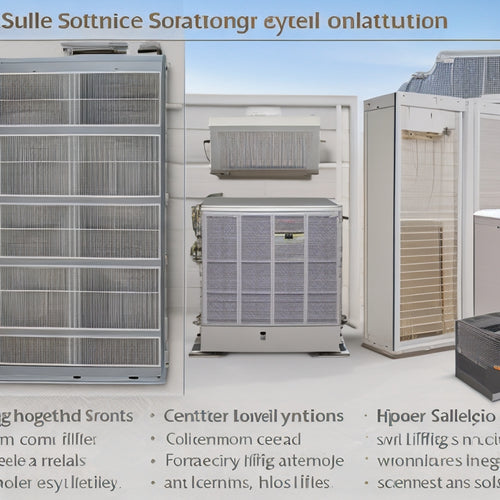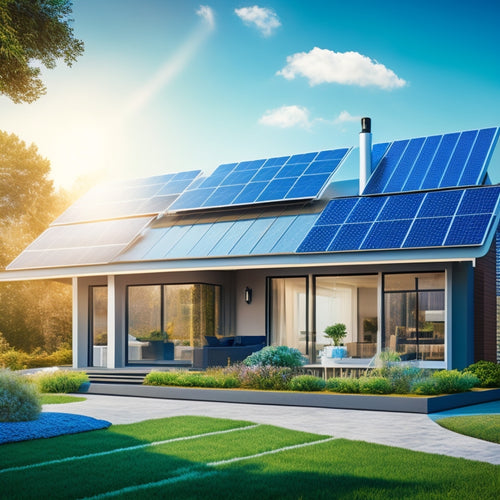
Decoding Heat Pump Efficiency: Understanding COP Ratings
Share
You're about to choose a heat pump, and understanding COP ratings is essential for making an informed decision. COP (Coefficient of Performance) measures a heat pump's efficiency, with higher ratings indicating more energy output for every unit of energy consumed. This directly affects your operational costs and monthly bills. As you evaluate heat pumps, you'll encounter different types, each with varying COPs, such as air-source and ground-source heat pumps. By grasping the factors that influence COP, you'll be able to select the right heat pump for your energy needs, and by exploring further, you'll discover the keys to revealing ideal performance and energy savings.
Key Takeaways
- A higher COP (Coefficient of Performance) indicates a heat pump's efficiency, with higher ratings translating to lower operational costs and energy bills.
- Different heat pump types, such as air-source and ground-source, exhibit varied efficiency metrics, with hybrid heat pumps offering improved efficiency.
- Factors like installation quality, ambient temperature, refrigerant type, and maintenance practices influence heat pump efficiency and energy consumption.
- Understanding seasonal COP ratings, such as HSPF and SEER, helps evaluate heat pump performance during different seasons and optimize energy usage.
- Proper system sizing, regular maintenance, and certification from organizations like ACHR or ECB ensure optimal heat pump performance and efficiency.
What Is COP in Heat Pumps
When shopping for a heat pump, you're likely to come across the term COP, or Coefficient of Performance, which measures the device's efficiency.
COP is an essential aspect of heat pump basics, as it determines how well the system converts electrical energy into usable heat or cooling. A higher COP indicates that the heat pump can provide more energy than it consumes, making it a more efficient and cost-effective option.
With the growing focus on environmental friendliness, choosing an energy-efficient heat pump is critical.
The COP significance lies in its ability to help you make an informed decision when selecting a heat pump. By understanding COP, you can choose a system that meets your energy needs while minimizing your carbon footprint and energy bills.
COP Vs SEER and EER
Three key metrics - COP, SEER, and EER - dominate the heat pump efficiency terrain, yet they're often confused or used interchangeably. You need to understand the differences to make informed decisions about your heat pump system.
COP measures the heat pump's ability to provide heating or cooling in a single operating mode. SEER, on the other hand, evaluates the system's cooling efficiency over an entire season. EER, similar to SEER, assesses cooling efficiency but at a higher outdoor temperature.
As consumers increasingly prioritize eco-friendly practices, integrating renewable energy sources into heat pump systems can greatly reduce carbon emissions.
When comparing COP ratings, consider the climate and technology advancements that impact energy usage and cost analysis. It's crucial to recognize these efficiency metrics and performance benchmarks to optimize your heat pump's operation and reduce energy consumption.
How COP Affects Your Bills
When you invest in a heat pump with a high COP, you're not just getting a more efficient system - you're also reaping energy cost savings.
By optimizing your solar panel array design, such as strategically orienting panels and sizing them to meet your energy needs optimal energy generation, you can further reduce your energy costs.
Your monthly bill impact will be significant, as a higher COP translates to lower operational costs.
Energy Cost Savings
Efficiency translates directly to your wallet, as a heat pump's Coefficient of Performance (COP) has a significant impact on your energy bills. A higher COP means you'll spend less on energy, and that's where the cost savings come in. When you're choosing a heat pump, it's crucial to evaluate the COP rating to ascertain you're getting the best energy efficiency.
| COP Rating | Energy Efficiency | Cost Analysis |
|---|---|---|
| 2.5 | 250% more efficient | 40% lower bills |
| 3.5 | 350% more efficient | 60% lower bills |
| 4.5 | 450% more efficient | 80% lower bills |
Monthly Bill Impact
Your energy cost savings directly correlate to the COP rating of your heat pump, and now it's time to examine how this efficiency translates to your monthly bills. A higher COP rating means you'll pay less on your energy bills, giving you more control over your energy management.
By choosing a heat pump with a high COP, you're adopting a smart billing strategy that optimizes your energy consumption. Additionally, investing in solar-powered systems, such as solar-powered charging stations, can lead to significant energy savings, reducing electricity bills and enhancing sustainability.
This, in turn, leads to lower monthly bills, freeing up more of your hard-earned money for the things that matter most. With a high-efficiency heat pump, you can enjoy the comfort of a warm home while keeping your energy costs in check, giving you the freedom to live life on your own terms.
Understanding Seasonal COP Ratings
When evaluating heat pump efficiency, you'll encounter seasonal COP ratings that reflect the unit's performance during distinct periods of the year.
Specifically, you'll want to examine the heating season performance factor (HSPF) and the cooling season energy efficiency ratio (SEER), which provide a more thorough understanding of your heat pump's capabilities.
As with commercial EV charging stations, it's crucial to take into account the impact of fast charging infrastructure on overall energy efficiency.
Heating Season Performance
How do heat pumps perform during the heating season, and what metrics can you rely on to gauge their efficiency?
When it comes to evaluating heat pump performance during the heating season, you need to look beyond a single COP rating.
You should consider the following factors:
-
Average outdoor temperatures: How well does your heat pump perform in freezing temperatures or mild winter conditions?
-
Heat pump maintenance: Regular maintenance can notably impact your heat pump's efficiency and overall performance.
-
Performance monitoring: Keep an eye on your heat pump's performance to identify areas for improvement and optimize its operation.
- Defrost cycle efficiency: How efficiently does your heat pump handle defrosting, and how does it impact overall performance?
Cooling Season Efficiency
During the cooling season, heat pumps operate in reverse, extracting heat from the indoor air and transferring it outside.
As you evaluate heat pumps for cooling performance, you'll come across efficiency metrics like Seasonal Energy Efficiency Ratio (SEER) and Energy Efficiency Ratio (EER).
These ratings indicate how efficiently a heat pump cools your space. SEER measures the total cooling capacity over the entire cooling season, while EER represents the cooling capacity at a specific outdoor temperature, usually 95°F.
Look for higher SEER and EER values to guarantee your heat pump provides peak cooling performance while minimizing energy consumption.
Factors Affecting Heat Pump COP
As you investigate the world of heat pumps, understanding the factors that influence their efficiency becomes vital. Several variables can impact your heat pump's Coefficient of Performance (COP), and being aware of them is essential for ideal performance.
The following factors can considerably affect your heat pump's COP:
-
Installation quality: A poorly installed heat pump can lead to reduced efficiency and increased energy bills.
-
Ambient temperature: Extreme temperatures can lower your heat pump's COP, making it work harder to heat or cool your space.
-
Refrigerant type and maintenance practices: The type of refrigerant used and regular maintenance can impact your heat pump's efficiency and longevity.
- Load conditions and airflow efficiency: Properly sizing your heat pump and ensuring good airflow can help maintain its COP.
COP and Heat Pump Types
Now that you've considered the factors affecting your heat pump's Coefficient of Performance (COP), it's time to investigate how different heat pump types impact this efficiency metric.
You'll find that various heat pump types exhibit distinct efficiency variations. For instance, air-source heat pumps typically have lower COPs than ground-source heat pumps, which can achieve COPs of 4 or higher.
Hybrid heat pumps, combining different heat sources, often fall in between. Additionally, the type of refrigerant used can influence COP, with newer alternatives like R-32 offering improved efficiency.
Understanding these differences is essential in selecting the most efficient heat pump for your specific needs, ultimately granting you the freedom to optimize your energy consumption.
Comparing COP Across Brands
When you're shopping for a heat pump, you'll likely encounter varying COP ratings from different brands.
However, it's essential to recognize that these ratings aren't always directly comparable, as manufacturers may employ distinct testing protocols or exaggerate their efficiency claims.
Brand Variations Matter
While exploring heat pump efficiency, you'll quickly uncover that brand variations play a notable role in determining the Coefficient of Performance (COP).
It's essential to acknowledge that different brands prioritize distinct aspects, resulting in varying COP ratings. Here are key factors to take into account when comparing COP across brands:
-
Brand reliability and warranty considerations: Reputable brands often offer longer warranties, ensuring your investment is protected.
-
Installation quality and maintenance practices: Proper installation and regular maintenance considerably impact a heat pump's efficiency.
-
User reviews and technology advancements: Research user experiences and look for brands that incorporate innovative technologies to enhance COP.
- Environmental impact and cost comparisons: Evaluate brands based on their environmental footprint and cost-effectiveness, considering factors like energy source and market trends.
Efficiency Claims Debunked
Investigate heat pump efficiency claims with a healthy dose of skepticism, as manufacturers' boasts often obscure the truth.
When comparing COP ratings across brands, it's crucial to debunk the myths and focus on the facts. Don't fall for inflated claims or misleading marketing tactics.
Instead, dig deeper to understand the testing conditions, climate zones, and operational modes that influence the ratings. By doing so, you'll gain a clearer depiction of a heat pump's true efficiency.
This myth-busting approach will enable you, the consumer, to make informed decisions and avoid overspending on a system that doesn't deliver.
Prioritize consumer awareness and demand transparency from manufacturers to guarantee you get the best value for your money.
COP and System Sizing Matters
Heat pump efficiency hinges on a delicate balancing act between Coefficient of Performance (COP) and system sizing.
You need to understand that a high COP rating doesn't guarantee peak performance if the system is undersized or oversized for your specific needs.
To achieve the perfect balance, consider the following:
-
System capacity: Confirm the heat pump's capacity matches your home's heating and cooling demands.
-
Sizing guidelines: Follow industry-standard sizing guidelines, such as those outlined by the Air-Conditioning, Heating, Refrigeration Certification Board (ACHR).
-
Load calculations: Perform accurate load calculations to determine the correct system size for your home.
- System design: Opt for a system design that integrates with your home's insulation, windows, and ductwork to maximize efficiency.
Heat Pump COP Certification
Now that you've optimized your heat pump's system sizing, it's time to verify the unit's COP rating is certified and trustworthy.
Heat pump certification is essential to confirm the unit meets efficiency standards. Look for certifications from reputable organizations, such as the Air-Conditioning, Heating, Refrigeration Certification Board (ACHR) or the European Certification Body (ECB).
These organizations test and verify heat pumps against strict efficiency standards, providing you with confidence in the unit's COP rating. Certified heat pumps have undergone rigorous testing, guaranteeing they meet minimum efficiency requirements.
This certification not only confirms the unit's performance but also helps you make an informed decision when selecting a heat pump that meets your needs and budget.
Optimizing COP in Real-World
Three key factors - proper installation, regular maintenance, and ideal operational conditions - greatly impact your heat pump's real-world COP.
These factors can remarkably deviate from the rated COP, making it vital to understand their influence.
To optimize your heat pump's COP in real-world applications, consider the following practical strategies:
-
Proper sizing: Verify your heat pump is correctly sized for your space to avoid inefficient operation.
-
Regular filter cleaning: Clean filters regularly to maintain airflow and prevent reduced COP.
-
Optimal refrigerant charge: Verify the refrigerant charge is accurate to prevent reduced COP and compressor damage.
- Defrosting management: Implement a defrosting schedule to minimize energy consumption and maintain COP.
Frequently Asked Questions
Can I Use COP to Compare Heat Pumps With Different Capacities?
When comparing heat pumps with different capacities, you can't solely rely on COP ratings for a fair capacity comparison, as they only reflect efficiency metrics at a specific capacity; consider other factors to get a thorough overview.
How Does Humidity Affect a Heat Pump's COP Rating?
As you step into the misty morning, humidity wraps around you like a damp blanket, affecting the heat pump's performance. You'll find that higher humidity levels directly impact the COP rating, skewing performance metrics and forcing the system to work harder, ultimately reducing its efficiency.
Are COP Ratings Affected by the Quality of Installation?
You're right to wonder if a heat pump's COP rating is affected by the quality of installation. The answer is yes, as subpar installation techniques and errors, such as improper refrigerant charging or misaligned components, can greatly reduce system efficiency and COP ratings.
Can I Calculate COP Using My Energy Bills and Usage Data?
A million calculations later, you're still wondering if you can decipher the COP code using energy bills and usage data - and the answer is yes! You can calculate COP by dividing the total energy output by energy consumption, revealing cost savings and unblocking true heat pump freedom.
Are There Any Government Incentives for High-Cop Heat Pumps?
You'll be pleased to know that yes, there are government incentives for high-COP heat pumps, including tax credits and energy rebates, which can greatly offset the upfront cost, giving you more freedom to invest in an efficient, eco-friendly system.
Related Posts
-

Why Solar HVAC Filters Revolutionize Home Energy Efficiency
By adopting solar HVAC filters, you're shifting your home's energy reliance from fossil fuels to clean, renewable sou...
-

7 Best Cool Roof Rebates for Energy-Savvy Homeowners
You're an energy-savvy homeowner looking to install a cool roof, and you're wondering which rebates can help you save...
-

What Are Natural Clay Paints for Green Home Interiors?
You're about to uncover a game-changing alternative to synthetic paints that not only enhances the aesthetic of your ...


